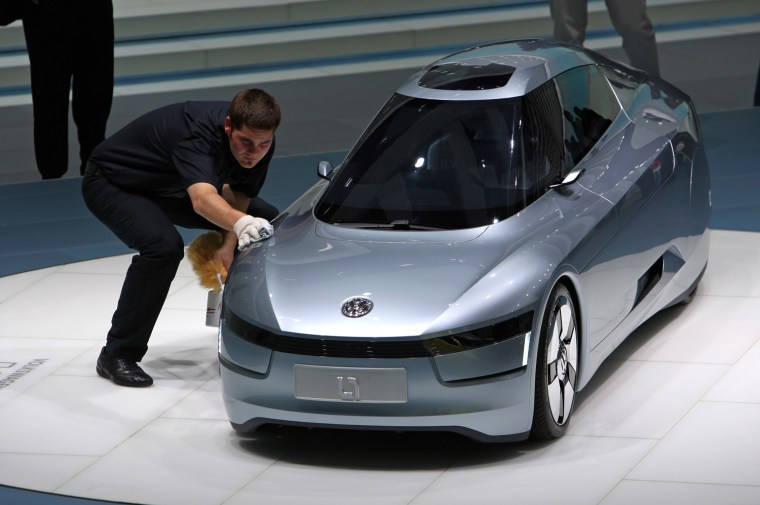The turnstiles have been spinning this week, as German motorists finally get the chance to see what all the media fuss has been about at the Frankfurt Motor Show.
From one end of the vast Frankfurt Messe, to the other — a distance of nearly a mile — close to 100 different vehicles are making their first public appearance.
There are, as one can expect in the land of the Autobahn, the obligatory high-performance sports cars, like the 197 mph Mercedes-Benz SLS, as well as plenty of sedans, crossovers and minicars.
But the theme of the 2009 Frankfurt Motor Show can best be summed up in one word: “electrification.” Virtually every manufacturer has unveiled a vehicle using the latest battery technology, whether hybrids or plug-ins, extended-range electric vehicles or pure battery cars.
And while industry officials may be quick to talk up the newest in electric transportation, they’ll also admit it’s not going to be easy abandoning the time-tested internal combustion engine. And the cost is likely to be substantial to governments, the industry and consumers.
“The battery cars of the past weren’t very sexy. Nobody cared,” said Peter Schwarzenbauer, global marketing director for Audi. “Now it’s sexy, and the prime topic at this show.”
The Audi e-tron is among the sexiest cars taking a bow at the 2009 Frankfurt Motor Show. With its aggressive, low-slung design, the 2-seater is a close cousin to the German maker’s R8 supercar, but uses a Lithium-Ion battery pack to power four individual motors, one for each wheel. Audi intends to put the e-tron — which can launch to 60 in just 4.8 seconds — into production in 2012.
At the other end of the vast Halle 5, Audi’s sibling division, Volkswagen, is targeting the other end of the automotive market. Its e-Up, which reaches showrooms in 2013, is based on VW’s new Up minicar, and is conceived as an urban commuter vehicle. It will be relatively low cost by battery car standards, but while VW isn’t giving out any hard numbers, industry observers expect it could cost twice as much as the gas or diesel-powered minicar.
The price of battery technology will come down with volume production, predicts Elon Musk, founder of California’s Tesla Motors, which is selling the $100,000 battery Roadster. The maker’s Model S will be a $57,000 family sedan with more room and more range.
But that’s still not cheap, and raises a basic question about which end of the market might be more open to battery technology. Audi CEO Rupert Stadler says his company is starting out with e-tron, because, “This is where the customer is most willing to pay a premium for this type of technology.”
Though initially slow to the segment, Mercedes-Benz is taking the same approach, in part because that may be the only way to keep its traditional product range alive. In major markets, such as the U.S. and Europe, they’re facing tough new restrictions on fuel consumption and the emissions of CO2, a gas strongly linked to global warming.
“Does sustainability mean we have to build small cars? Not necessarily,” insists Dr. Thomas Weber, the Daimler AG board member in charge of technology, pointing to the S500, a battery-based version of Mercedes’ big S-Class, which could get up to 70 mpg.
But even if luxury customers accept the higher cost of battery technology, they face problems similar to those who’d buy the tiny e-Up. Range, for one thing. Even the latest LIon technology has trouble delivering much more than 150 miles per charge.
One possible way to get around this is with an Extended-Range Electric Vehicle, like the Opel Ampera, which borrows its E-REV technology from the Chevrolet Volt. When the battery runs down, after about 40 miles, the car switches on its gasoline engine and keeps going.
Even then, Ampera needs to be plugged in overnight, just like e-Up and e-Tron. That might be easy for suburban commuters with a garage, but many potential customers live in urban centers, where gaining access for their car to a basic electric socket or a high-power, high-speed charger could prove difficult.
Working with the German government and an alliance of energy providers, a consortium of German automakers, including Mercedes and BMW, plan to invest at least $1.5 billion over the coming decade, eventually creating about 1,000 alternative power service stations across the country. Each will provide both chargers and access to hydrogen, the clean, lightweight fuel used by the BMW Hydrogen7 and Mercedes’ new F-Cell, the latter also debuting in Frankfurt.
“But where will that energy come from?” asked Johan de Nysschen, CEO of Audi of America. Like many battery skeptics, he warns that there could be a need for a lot more electric power plants, if EVs catch on, “but if we use dirty power, like coal, we’re just swapping emissions from the tailpipe for emissions from the smokestack.”
Even the biggest proponents of electrification, speaking in Frankfurt, acknowledged there are numerous challenges to the widespread adoption of the technology. Some manufacturers are looking at alternative business models, for example. Nissan may sell motorists the company’s new Leaf battery-electric vehicle, but lease the LIon battery pack at a rate close to what a typical driver would spend on fuel each month.
The wild card is consumer acceptance, of course, and no one is certain how widespread that will be. “The common thinking,” said Audi’s Schwarzenbauer, is that “It will take until 2030 to have half of the market go electric.”
Even that figure is a matter of debate. But considering the pressure to find a clean alternative to the internal combustion engine, no one is willing to risk sitting on the sidelines, which is why some form of electric propulsion was the price of entry at the 2009 Frankfurt Motor Show.
